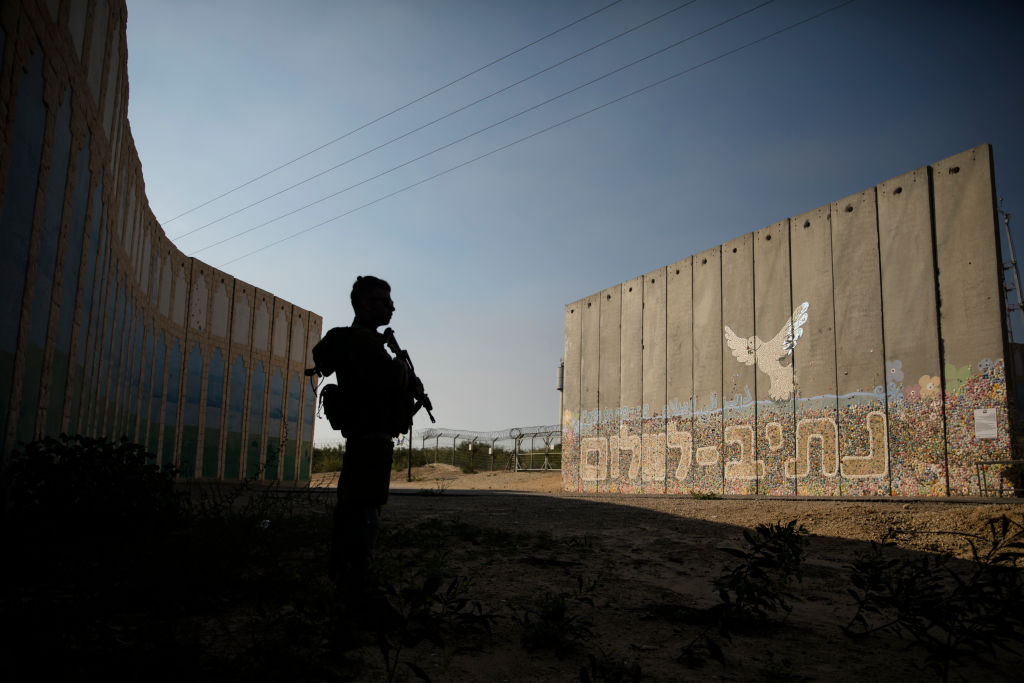
Is there any possibility of peace between Israel and the Palestinians, or must we simply get used to periodic wars that deny both sides the tranquillity and stability they seek?
It’s easy to be pessimistic. The history of the region is littered with failed peace plans, collapsed diplomatic conferences and thoroughly disillusioned mediators. Everything seems to have been tried, and nothing seems to have worked. Everyone is left assigning blame to anyone but themselves.
Yet to give up on diplomacy is to accept the unacceptable: eternal war. That’s why, even amid the horrors of the latest Gaza war, talk of an eventual two-state solution remains alive and has actually grown louder.
At his 3 November press conference in Tel Aviv, US Secretary of State Antony Blinken went further in describing a lasting solution than any US official has in a long time—if ever. A two-state solution, he averred, is ‘the only guarantor of a secure, Jewish and democratic Israel; the only guarantor of Palestinians realising their legitimate right to live in a state of their own, enjoying equal measures of security, freedom, opportunity and dignity; the only way to end a cycle of violence once and for all’.
Blinken is right. Ensuring an ‘equal measure of security, freedom, opportunity and dignity’ for everyone between the Jordan River and the Mediterranean is the only ultimate solution. European leaders acknowledged this reality back in 1980 with the Venice Declaration. The nine members of the European Community proclaimed: ‘The Palestinian people, which is conscious of existing as such, must be placed in a position, by an appropriate process defined within the framework of the comprehensive peace settlement, to exercise fully its right to self-determination.’
By that time, Arab governments had given up on trying to erase the state of Israel. Following their failure in the 1973 Yom Kippur War, they finally agreed to make peace. But as the Venice Declaration recognised, true regional peace wouldn’t be possible until the Palestinian issue was settled.
In the optimistic early 1990s, the Oslo Accords showed what was possible. Palestine Liberation Organization Chairman Yasser Arafat (an ex-terrorist) and Israeli Prime Minister Yitzhak Rabin (an ex-general) shook hands on the White House lawn. The path to a two-state solution had been established, even if crucial details remained to be settled.
But the Oslo process eventually failed, owing to opposition boiling up among Israelis and Palestinians alike. The earlier optimism gave way to Palestinian terrorism and illegal Israeli settlements, and it has been downhill ever since. While successive US administrations have made repeated attempts to revive the peace process, none has made it a top priority. Until 7 October, Joe Biden’s administration had left the issue on a back burner, hoping that the region would remain calm while it concentrated on other matters.
For its part, the European Union long maintained a forward-looking commitment to the Middle East peace process. In December 2009, it issued a detailed pronouncement calling for ‘a two-state solution with the State of Israel and an independent, democratic, contiguous and viable State of Palestine, living side by side in peace and security.’ But Europe’s interest in the issue also waned over time. Though there were various reasons for that, Israeli Prime Minister Benjamin Netanyahu’s consistent efforts to make serious peace talks impossible surely played a significant role.
Moreover, politicians in America, Europe and Israel began to convince themselves that the Palestinian issue could simply be forgotten, since more Arab countries had begun to establish formal diplomatic relations with Israel. ‘If the Arab world no longer cares about the Palestinians,’ they thought, ‘why should we?’
Now that the political quagmire and humanitarian disaster in Gaza has returned the issue to the fore, it’s clear that there can be no resolution without some decisive steps towards a two-state solution.
But we shouldn’t harbor any illusions. The obstacles are huge. Among the most worrying is the apparent increase in support for violence among Palestinians who have grown frustrated to the point of despair. Hamas isn’t the only organisation that sees terror as the best way forward. In the West Bank, too, the Palestinian Authority has lost control of some areas where it is supposed to provide security and order.
Another major obstacle is the inclusion of fundamentalist Jewish settlers in the current Israeli government. There are now an estimated 700,000 people living in illegal settlements scattered across territory that is supposed to belong to a future Palestinian state. Many of these settlers are armed, and since 7 October have been violently forcing hundreds of Palestinians from their homes. Some even dream openly of demolishing the Dome of the Rock and the Al-Aqsa Mosque, so that they can rebuild the biblical Temple in Jerusalem (which was destroyed by the Babylonians in 587 BC, and again by the Romans in 70 AD).
Extremists on both sides want to control all of the land between the river and the sea by whatever means necessary. If either is allowed to gain further ground, this war will become even deadlier than it already is.
The key, then, is to use the renewed prospect of a two-state solution to galvanise moderate forces on both sides—and to do so fast, before more people succumb to fatalism or despair. Such a reopening won’t happen without strong, sustained international engagement by the US, the EU and the other Arab states. With Russia having ostracised itself with its war of aggression against Ukraine, the international community will need a new format to replace the previous Middle East Quartet (the EU, the US, the United Nations and Russia).
Though upcoming elections in the US and elsewhere may divert attention next year, the issue should be made a top priority thereafter. We must never give up on diplomacy. We have now been reminded of what the alternative looks like.

